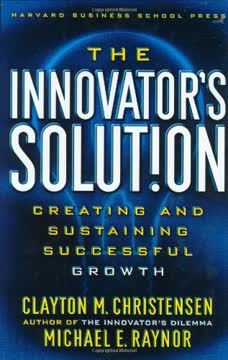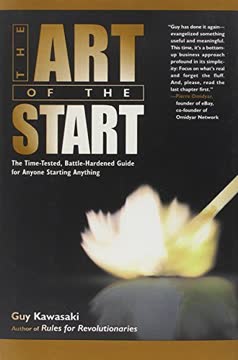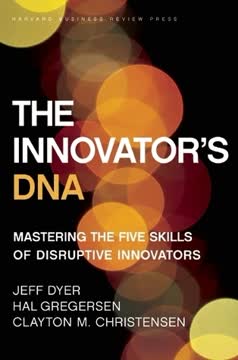Key Takeaways
1. Innovation is a skill that can be learned and developed
"Creativity is not just a genetic endowment and not just a cognitive skill. Rather, we've learned that creative ideas spring from behavioral skills that you, too, can acquire to catalyze innovative ideas in yourself and in others."
Nature vs. Nurture: While some people may seem naturally more creative, research shows that innovation skills can be developed. A study of identical twins found that only about 30% of creative performance could be attributed to genetics, leaving 70% to environmental factors and learned behaviors.
Innovator's DNA: The authors identify five key "discovery skills" that innovative individuals consistently demonstrate:
- Associating: connecting seemingly unrelated ideas
- Questioning: challenging the status quo
- Observing: paying close attention to details and behaviors
- Networking: seeking diverse perspectives
- Experimenting: testing new ideas and experiences
By consciously practicing and developing these skills, anyone can enhance their capacity for innovation and creative problem-solving.
2. The five discovery skills of innovators: Associating, Questioning, Observing, Networking, and Experimenting
"Innovators consistently demonstrate five discovery skills that distinguish them from typical executives."
Core skills: The five discovery skills form the foundation of the "Innovator's DNA" and work together to spark creative insights:
- Associating: Making unexpected connections between ideas
- Questioning: Challenging assumptions and asking provocative questions
- Observing: Noticing details others might miss
- Networking: Seeking diverse perspectives and knowledge
- Experimenting: Trying new experiences and testing ideas
Synergy and practice: While individuals may naturally excel in one or two of these skills, the most successful innovators actively cultivate all five. By consciously engaging in these behaviors, anyone can improve their ability to generate creative ideas and solutions.
3. Associating: The cognitive skill of connecting seemingly unrelated ideas
"Creativity is connecting things."
Cognitive foundation: Associating is the primary cognitive skill that underlies innovative thinking. It involves linking seemingly unrelated questions, problems, or ideas from different fields or contexts to generate novel solutions.
Techniques to enhance associating:
- Force new associations: Deliberately combine unrelated concepts
- Use metaphors and analogies: Find connections between disparate ideas
- Build a "curiosity box": Collect interesting objects to spark new associations
- Practice SCAMPER: Use this technique to modify and combine existing ideas
- Engage in "combinatorial play": Explore how different concepts might interact
By actively seeking diverse experiences and knowledge, innovators build a rich mental database of ideas that can be combined in unexpected ways.
4. Questioning: The art of challenging the status quo and asking "What if?"
"The formulation of a problem is often more important than its solution."
Power of inquiry: Questioning is a critical skill for innovators, allowing them to challenge assumptions, reframe problems, and uncover new possibilities. Innovative leaders ask more questions and more provocative ones than their peers.
Effective questioning techniques:
- Ask "Why?", "Why not?", and "What if?" questions
- Use the "Five Whys" technique to dig deeper into root causes
- Practice "QuestionStorming": Generate questions about a problem before seeking solutions
- Impose or remove constraints: Ask how a solution might change under different conditions
- Cultivate a high "Q/A ratio": Prioritize asking questions over providing answers
By developing a questioning mindset, innovators can identify opportunities that others might overlook and approach problems from fresh perspectives.
5. Observing: Gaining insights through keen attention to detail
"Innovation begins with an eye."
Anthropological approach: Innovative individuals are intense observers, carefully watching the world around them to identify problems, unmet needs, and potential solutions. They often notice things that others overlook.
Observation techniques:
- Watch for "workarounds": Identify how people solve problems with existing tools
- Look for surprises or anomalies: Pay attention to unexpected behaviors or results
- Engage all senses: Observe not just visually, but through touch, smell, sound, and taste
- Practice "vuja de": See familiar situations as if for the first time
- Immerse yourself in new environments: Travel, visit new places, or try new experiences
By honing their observational skills, innovators can uncover insights that lead to breakthrough ideas and solutions.
6. Networking: Discovering new ideas through diverse connections
"Ideas for Innovation: If you have a good gut feeling for which general direction to go, then you should just run as fast as you can."
Idea networking: Innovative individuals actively seek out diverse perspectives and knowledge by connecting with people from different backgrounds, industries, and disciplines. This "idea networking" differs from traditional networking focused on career advancement or resource acquisition.
Networking strategies:
- Attend idea-focused conferences and events (e.g., TED, World Economic Forum)
- Build a personal network of creative confidants
- Actively seek out people with different expertise and backgrounds
- Practice "intellectual humility": Be open to learning from anyone
- Use networking to test and refine ideas
By expanding their network of diverse connections, innovators increase their exposure to new ideas and perspectives that can spark creative insights.
7. Experimenting: Testing ideas through prototypes and pilot projects
"Experiments are key to innovation because they rarely turn out as you expect, and you learn so much."
Hands-on approach: Innovative individuals are active experimenters, constantly trying out new experiences, taking things apart, and testing ideas through prototypes and pilots. This hands-on approach generates valuable data and insights.
Experimentation techniques:
- Develop rapid prototypes to test ideas quickly
- Conduct small-scale pilot projects before full implementation
- Try out new experiences and learn new skills
- Disassemble products (physically or intellectually) to understand how they work
- Create low-cost experiments to test hypotheses
By embracing a "fail fast, learn fast" mentality, innovators can quickly iterate and improve their ideas based on real-world feedback.
8. The DNA of innovative organizations: People, Processes, and Philosophies
"The DNA of innovative organizations mirrors the DNA of innovative individuals."
Organizational innovation: Highly innovative companies cultivate an environment that supports and encourages innovation at all levels. This is achieved through three key elements:
- People: Hiring and developing individuals with strong discovery skills
- Processes: Implementing systems that encourage questioning, observing, networking, and experimenting
- Philosophies: Fostering a culture that values innovation and risk-taking
Key characteristics:
- Leadership that actively participates in innovation
- Diverse teams with complementary skills and perspectives
- Processes that mirror the discovery skills of individual innovators
- A culture that encourages questioning and experimentation
By aligning these elements, organizations can create a sustainable environment for innovation and creative problem-solving.
9. Building a culture of innovation in your organization
"Innovation is everyone's job, not just R&D's."
Organizational mindset: Innovative companies foster a culture where all employees are expected and encouraged to contribute creative ideas. This requires a shift in mindset and supporting structures.
Strategies for building an innovative culture:
- Lead by example: Senior leaders should actively engage in innovation
- Allocate time and resources for innovation (e.g., Google's "20% time")
- Reward and recognize innovative efforts, not just successes
- Create physical spaces that encourage collaboration and creativity
- Implement processes for sharing and developing ideas across the organization
- Encourage cross-functional and diverse teams
By making innovation a core part of the organizational culture, companies can tap into the creative potential of all employees and stay ahead of the competition.
10. Taking smart risks and learning from failure
"If you're not prepared to be wrong, you'll never come up with anything original."
Embracing failure: Innovative organizations understand that failure is an inevitable part of the innovation process. They create an environment where calculated risks are encouraged and failure is seen as a learning opportunity.
Strategies for smart risk-taking:
- Develop a portfolio approach to innovation projects
- Encourage small experiments and rapid prototyping
- Celebrate learning from failures, not just successes
- Create safe spaces for employees to share and test new ideas
- Implement processes for capturing and sharing lessons learned
- Balance risk-taking with rigorous analysis and planning
By reframing failure as a valuable part of the innovation process, organizations can foster a culture of experimentation and continuous improvement.
11. Developing discovery skills in yourself and others
"Improvement begins with I."
Personal growth: Enhancing your own discovery skills is the first step towards becoming a more innovative leader and fostering innovation in others.
Strategies for skill development:
- Assess your current discovery skills and identify areas for improvement
- Set specific goals for practicing each discovery skill
- Find a mentor or coach to support your development
- Create opportunities for others to practice discovery skills
- Incorporate discovery skill development into performance reviews and training programs
- Model innovative behaviors and encourage others to do the same
By actively developing discovery skills in yourself and others, you can create a ripple effect of innovation throughout your organization and beyond.
Last updated:
FAQ
What's The Innovator's DNA about?
- Focus on Innovation: The Innovator's DNA by Jeffrey H. Dyer explores the essential skills and behaviors that drive disruptive innovation in individuals and organizations.
- Five Discovery Skills: It identifies five key discovery skills that innovators possess: associating, questioning, observing, networking, and experimenting.
- Research-Based Insights: The book is based on extensive research, including interviews with nearly a hundred successful innovators and CEOs, to uncover how they generate groundbreaking ideas and business models.
- Practical Application: It provides actionable insights and frameworks that readers can apply to enhance their own innovative capabilities and foster a culture of innovation within their organizations.
Why should I read The Innovator's DNA?
- Enhance Creativity: Reading this book can help you develop your creative thinking skills, which are vital for success in today’s fast-paced business environment.
- Learn from Innovators: The book shares stories and lessons from well-known innovators like Jeff Bezos and Steve Jobs, offering real-world examples of how they applied the five discovery skills to achieve success.
- Actionable Frameworks: It provides practical frameworks and exercises that you can implement to cultivate innovation in your personal and professional life.
What are the key takeaways of The Innovator's DNA?
- Five Discovery Skills: Emphasizes the importance of associating, questioning, observing, networking, and experimenting as critical skills for generating innovative ideas.
- Behavior Over Genetics: Challenges the notion that creativity is solely a genetic trait, arguing that anyone can develop these skills through practice and intentional behavior changes.
- Courage to Innovate: Innovators are characterized by their willingness to challenge the status quo and take smart risks, which is essential for fostering a culture of innovation.
What are the best quotes from The Innovator's DNA and what do they mean?
- “Creativity is connecting things.”: This quote by Steve Jobs highlights the essence of associational thinking, linking seemingly unrelated ideas to generate innovative solutions.
- “I want to put a ding in the universe.”: Reflects the ambition and drive of innovators to make a significant impact through their ideas and creations.
- “Question the unquestionable.”: Emphasizes the importance of questioning established norms and assumptions, a key behavior of successful innovators.
What is the Innovator's DNA model?
- Cognitive and Behavioral Skills: The model consists of a cognitive skill called associational thinking, complemented by four behavioral skills: questioning, observing, networking, and experimenting.
- Interconnectedness: These skills are interrelated; engaging in one often enhances the others, leading to a greater capacity for innovation.
- Framework for Development: Serves as a framework for individuals and organizations to assess and develop their innovative capabilities.
How can I develop my associating skills as described in The Innovator's DNA?
- Create Odd Combinations: Practice combining unrelated ideas or concepts to generate new insights through exercises like forced associating.
- Engage in Diverse Experiences: Actively seek out new experiences and knowledge across various fields to expand your mental repository of ideas.
- Practice Lego Thinking: Collect ideas and insights like Lego blocks, and experiment with different combinations to create innovative solutions.
What role does questioning play in innovation according to The Innovator's DNA?
- Catalyst for Discovery: Questioning is a fundamental behavior that drives the discovery process, helping innovators challenge the status quo and explore new possibilities.
- Types of Questions: Innovators ask a variety of questions, including “what is,” “what caused,” “why,” and “what if,” to gain deeper insights and provoke new ideas.
- Encouraging Curiosity: Emphasizes the importance of maintaining a curious mindset and being willing to ask difficult or uncomfortable questions to uncover innovative solutions.
How does observing contribute to innovation in The Innovator's DNA?
- Understanding Customer Needs: Observing customers in their natural environments allows innovators to identify unmet needs and potential improvements for products or services.
- Looking for Anomalies: Innovators are encouraged to look for surprises or anomalies in customer behavior, which can lead to valuable insights and innovative ideas.
- Engaging All Senses: Effective observation involves engaging multiple senses to gain a richer understanding of the context and experiences of customers.
What is the significance of networking in The Innovator's DNA?
- Diverse Perspectives: Networking with individuals from different backgrounds and industries can provide fresh insights and ideas that enhance creativity and innovation.
- Bridging Structural Holes: Discusses the concept of bridging gaps between social networks to access diverse information and perspectives, leading to innovative solutions.
- Building a Personal Network: Innovators are encouraged to cultivate a personal network of creative confidants who can challenge their thinking and provide new ideas.
How can I implement the principles from The Innovator's DNA in my organization?
- Foster a Culture of Innovation: Encourage behaviors that promote the five discovery skills among employees, such as questioning, observing, networking, and experimenting.
- Provide Training and Resources: Offer training programs and resources that help employees develop their innovative capabilities and apply the principles from the book.
- Create Safe Spaces for Experimentation: Establish environments where employees feel safe to experiment, take risks, and share their ideas without fear of failure.
How can I develop my discovery skills as suggested in The Innovator's DNA?
- Practice Regularly: Actively engage in questioning, observing, networking, and experimenting in your daily life to reinforce these skills.
- Seek Feedback: Collaborate with others and seek their input to enhance your understanding and application of discovery skills.
- Embrace Failure: View failures as opportunities for growth, which is essential for developing experimentation skills and fostering resilience.
How does The Innovator's DNA suggest organizations can implement innovation processes?
- Structured Processes: Develop systematic processes that encourage questioning, observing, networking, and experimenting among employees.
- Small Teams: Organize employees into small, cross-functional teams to enhance collaboration and creativity.
- Resource Allocation: Allocate sufficient resources—both time and funding—to support innovation initiatives, demonstrating a commitment to fostering a culture of innovation.
Review Summary
The Innovator's DNA received mixed reviews. Many praised its insights on innovation skills but criticized its repetitiveness. Readers appreciated the five key skills for innovation: associating, questioning, observing, networking, and experimenting. Some found the book practical and transformative, while others felt it lacked originality. The research-based approach was commended, but the repetitive examples and anecdotes were seen as a drawback. Overall, readers valued the core concepts but felt the book could have been more concise.
Similar Books









Download PDF
Download EPUB
.epub digital book format is ideal for reading ebooks on phones, tablets, and e-readers.




